Why a gas stove is shocking: popular reasons and recommendations for their elimination
It often happens that when you touch the body of the gas stove, you feel "tingling." This is unpleasant, but the worst thing is that such minor troubles often turn into grandiose problems and damage to gas equipment. And nobody needs such a development of the situation, right?
Therefore, when the gas stove is shocking, it is necessary to immediately identify the cause and eliminate it. Moreover, this can be done promptly. And how to find the source of the problem and what to do in this case - we will consider all this in detail in our article.
The content of the article:
- Reasons and methods for eliminating leakage currents
- Reason # 1 - lack of grounding
- Reason # 2 - violation of insulation integrity
- Reason # 3 - contact oxidation
- Reason # 4 - wire integrity violation
- Reason # 5 - breakdown of the electric heating grill
- Reason # 6 - the formation of a conductive "bridge"
- Reason # 7 - problems with capacitors
- Reason # 8 - the influence of interference from other devices
- Reason # 9 - outlet malfunction
- If grounding is not provided?
- Conclusions and useful video on the topic
Reasons and methods for eliminating leakage currents
Touching the gas stove sometimes causes discomfort due to the impact of small current discharges on the user. The power of which usually does not exceed 110 Volts, so they are not dangerous to life and even health.
But still, the presence of electricity on the body and other structural elements of the gas stove indicates that there is a malfunction. And dangerous, because it is caused by a leakage of current.
No less dangerous is the independent repair of equipment. Therefore, all that needs to be done, if it is revealed that the gas stove is shocking, is to report any problems to the gas company with which service contract signed and provide an opportunity for a visiting master to fulfill his duties.

There are many reasons why a gas stove begins to be shocked:
- lack of grounding;
- violation of the integrity of the insulation of wires;
- contact oxidation;
- violation of the integrity of the wires;
- breakdown of the heater, if the gas stove is equipped with an electric grill, oven;
- formation of a conductive "bridge" due to the accumulation of foreign particles, liquids inside the plate;
- liquid getting on contacts, other conductive elements of the gas stove construction. As a result, a circuit is closed on its housing;
- problems with the capacitor;
- shielding;
- malfunction of the outlet.
Interestingly, in the last two cases, the stove is a "hostage of the situation." Since it is serviceable, but its performance is reduced by external factors.
Since any of the listed reasons causing electric shocks when using a gas appliance for cooking is dangerous, it is worth introducing them better.
Reason # 1 - lack of grounding
The design of any modern gas stove is designed to prevent leakage of electrical energy. But the voltage on the cases of the specified equipment still arises often.
And the main problem leading to electric shock of various voltages is lack of grounding. Which is a set of solutions to exclude the user's defeat by electric discharge. And no matter what it is: insignificant or deadly.
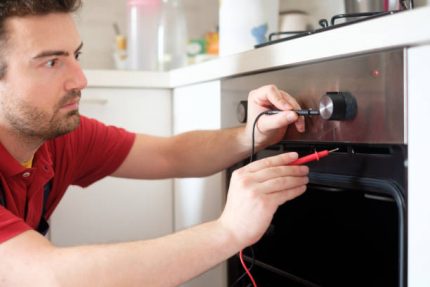
The situation is compounded by the fact that most houses were built in Soviet times, and then there were no standards that would regulate the use of effective grounding systems for cases of current leakage. Therefore, the vast majority of users are not protected from its impact.
Today's new buildings are equipped with the necessary equipment. But the lack of a culture of use and low technical literacy lead to the fact that after a few years, grounding in many buildings exists only on paper.
The reason is that users do not monitor the status of protective devices, which as a result lose their functionality due to the influence of a number of negative factors. Most often this is humidity, quickly enough leading to the oxidation of the terminals.
Improper design often leads to problems with grounding, then individual elements or its entire structure is exposed to high temperatures and intense ultraviolet radiation.
In both cases, grounding becomes ineffective over time. That will not allow to divert the necessary amount of electricity at a critical moment from gas stoves and other household appliances.
How to identify a problem with the lack of grounding?
If the outlet where the gas stove is connected has only 2 outputs for wires, then this means that it is not grounded. This will be the reason that the user is affected by current discharges.
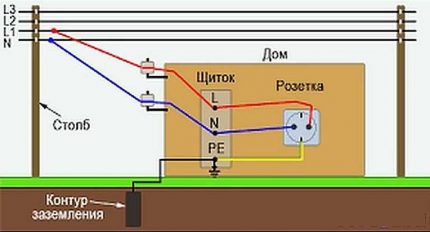
When the socket to which the device is connected “pinches” fingers and other parts of the body with current, has 3 leads on the wires, then check ground. What is done with a multimeter.
Grounding Recovery
If the ground loop is provided, but simply failed, then it is necessary to identify the cause and eliminate it so that the gas stove ceases to be shocked.
Among the reasons the most popular are such as:
- terminal oxidation;
- damage to the ground loop design.
In the first case, the restoration of performance is performed by cleaning the terminals or replacing them.
If the structure is damaged, a faulty section or assembly is detected and the breakdown is eliminated.The method of repair and the amount of work is determined individually in each case. For example, if the wires are broken, then they are connected or part of the wiring is replaced, which will exclude electric shocks when touching the plate body.
Reason # 2 - violation of insulation integrity
Today, to increase functionality and ensure operability, the design of gas stoves is crammed with a large number of wires. The insulation of which is easily destroyed by exposure to high temperatures and mechanical stress.
Sometimes gas stoves come with defective wires. In addition, insulation is destroyed during aging. All of the above becomes the cause of the malfunction. The problem is resolved by replacing damaged wires.
To identify which methods are used:
- visual inspection;
- resistance measurements on separate sites.
In the latter case, you need to use a multimeter with a megaohmmeter function. Before starting the “ringing” procedure, the stove must be de-energized.
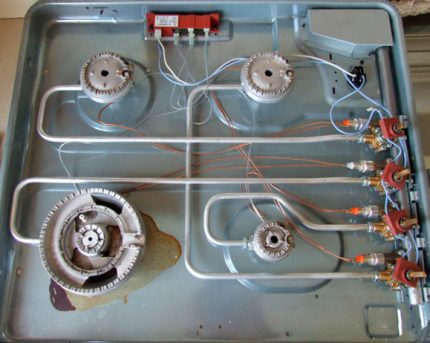
Despite the fact that the procedure for identifying the problem area and wire connections quite simple, it should be understood that gas equipment is a source of increased danger, so even they should be entrusted to specialists.
Reason # 3 - contact oxidation
Traditionally, trouble spots are not isolated sections. The reasons are usually operating in difficult conditions. That is, elevated temperatures, their regular drops and even the usual overflow of liquids, which quite often happens when cooking food, affects it.
The methods for detecting and eliminating the malfunction are the same as in the case of a violation of the integrity of the insulation of the wires. All features are described in the previous paragraph.
Reason # 4 - wire integrity violation
Damage to such structural elements of slabs occurs under critical mechanical loads. And often this happens through the fault of users. For example, during the removal of contaminants that have fallen into the inside of a gas stove. Or when trying to adjust, replace any parts (candles, temperature sensors).
It is often possible to detect a malfunction visually. In other cases, you must use a multimeter.

The best way to repair the damage is to replace it. That is, you should not take risks by connecting dangling wires to each other.
Reason # 5 - breakdown of the electric heating grill
The presence of such a problem is often indicated by an unreasonable increase in the temperature of the housing or of the electric heating element itself, even when it is in the off position.
It will be possible to eliminate the malfunction by replacing the problematic structural element. What should be entrusted to the master.
Reason # 6 - the formation of a conductive "bridge"
Most gas stove electrical appliances are located under the gas stove table and next to the burners. That is, they are not sufficiently protected from spilled liquids, fat, food particles. Which leads to the formation of contaminants directly on the surfaces of auto-ignition candles, temperature sensors, wires. The situation is exacerbated by dust and high temperatures, which can lead to melting, combustion of third-party particles.
All of the above makes the operating conditions of electrical equipment difficult, often leading to damage to the integrity of the insulation of wires or other damage.And then the situation is complicated by the fact that so-called conductive "bridges" are created that lead to current shocks of various strengths.
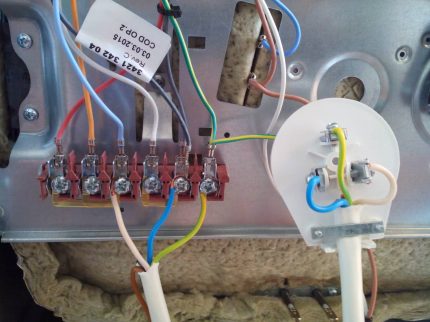
But often the electrical equipment remains in good condition. To check this, it is necessary to clean the stove.
Why do the following:
- Switch off the gas stove.
- Dismantle the table plate.
- Clean electrical equipment. Namely, temperature sensors, candles, auto ignition blocks, wiring. What they do with brushes, detergents.
- Measure the resistances of all electrical elements of the gas stove structure.
If there are no malfunctions, then the operation of the gas appliance can be continued. If a problem is detected, the faulty node is replaced with a new one.
Reason # 7 - problems with capacitors
Capacitors are used to smooth out impulse noise. And usually they are reliable. But, nevertheless, if the presence of more common causes of breakdowns has not been confirmed, and you still have not found out why it is shocking from your gas stove, then you should find a capacitor and check its performance.
Defective capacitors must be replaced.
Reason # 8 - the influence of interference from other devices
In this case, the gas stove is absolutely operational. Nevertheless, users will regularly experience current discharges.
The fact is that the voltage on the plate body appears interference from other electrical appliances (washing machines, underfloor heating, etc.). And it may be that they are located in neighboring rooms, apartments.
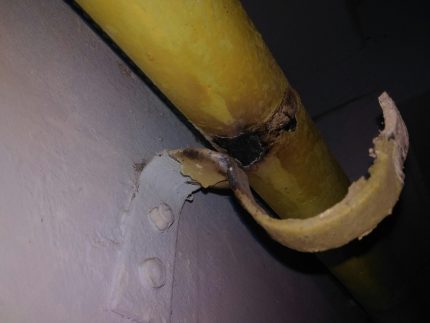
In simple cases, the malfunction can be eliminated by the user. For example, sometimes for this you just need to move a nearby washing machine or use non-conductive coasters, gaskets. For example, installing them between a stove and a pipe or other equipment.
But in most cases, an invitation to a specialist can not do.
Reason # 9 - outlet malfunction
Although the outlet is not part of the plate, it is a frequent cause of current on the structural elements of the plate.
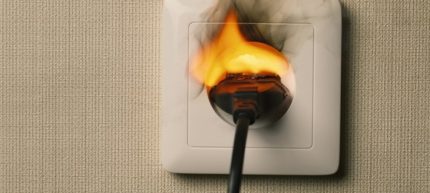
The functionality of outlets is affected by different types of loads, namely:
- mechanical;
- current.
If in the first case the breakdown occurs quickly and usually its consequences are visible visually, then with critical current loads the problem can be hidden, and for a long time. Or to have not pronounced signs in the form of minor discharges of electricity. But in the end, it all ends with a breakdown of the gas stove, and sometimes with accidents.
therefore faulty outlet should be replaced, and promptly.
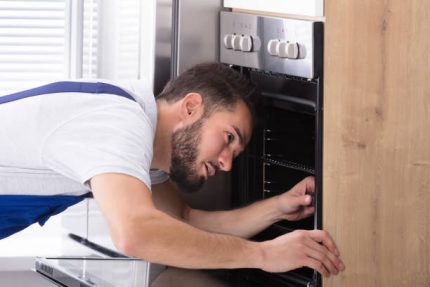
After completion of work, it is necessary to perform a functional check.
All, without exception, operations must be performed by specialists. The reason is that most jobs require specialized knowledge and skills.
If grounding is not provided?
For a multi-story building (residential, non-residential), developers usually create a single ground loop.
In the same way it is necessary to approach the solution of problems to residents of houses in which grounding is not provided. When all electrical appliances in the house are grounded, it will be possible to achieve the optimal level of fire safety.
And the creation of a single circuit in a multi-storey building will facilitate its official design. This is an important point, because grounding can be operated legally only after permission is given.
Why do you need to perform a number of actions:
- Create a project.
- Coordination of the project with Rostekhnadzor and the company that supplies electricity.
- Creating a ground loop.
- Verification of the operability of the design, which should be performed by representatives of the energy supervision authorities.
If the house is large and the total power consumption of electricity exceeds 100 kW, then when changing the project you will have to get an admission certificate. This document is unlimited and allows you to operate home electrical equipment.
Individual grounding for the apartment
And now we’ll figure out what to do if the gas stove suddenly began to shock, and the owners of other rooms in the house do not want to take care of security. In this case, it is possible to get out of the situation yourself. Why do you need to create an individual grounding.

But it should be remembered that "partisan" actions cannot be taken. That is, a metal bucket buried under the window is not the right solution. Since this will violate the provisions of a number of documents: chapter 1.7 PUE, where the requirements for grounding conductors are taken into account, and, possibly, the terms of the contract of the management company with the electricity supplier. Therefore, the procedure for creating grounding should begin with coordination.
If there are no obstacles from other interested parties, then you should create a project and coordinate it in Rostekhnadzor. And then you can start work.
Which, as in the case of the general contour for the entire building, must end with the invitation of specialists of energy supervision authorities to carry out the inspection.
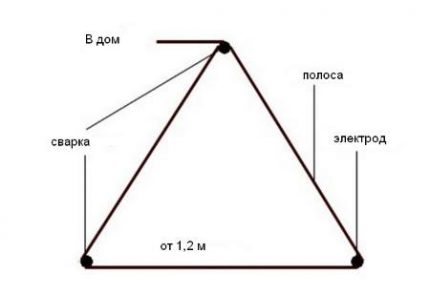
About what the protective circuit should be said in the PUE. Chapter 1.7 of which indicates that it is made from a number of mandatory elements:
- Single core PE conductor, which serves to divert electricity in case of leakage. It is a copper or aluminum wire.
- Ground bus. Such a device is usually placed on each floor of the building. The protective circuits of individual apartments and other rooms are connected to the main bus and connected.
- Electrodes and plates (made of metal conductive corners, pins) in the amount of 3 pieces. The pins are connected by plates at an equal distance from each other. Then they drive into the ground near the building.
Without fail, all conductive parts of the structure must be insulated. This is done in order to exclude electric shock when directly or indirectly touched.
If you live in a private house, not in an apartment, we recommend that you familiarize yourself with arrangement instructions ground loop in the house.
The wires used to create protection against leakage of electricity must have:
- the cross-sectional area is the same as that of a phase wire with a cross-section of up to 16 mm²;
- the cross-sectional area is not less than 16 mm², if a similar indicator of the phase wire is in the range of 16-35 mm²;
- the cross-sectional area is not less than half that of a phase wire.
That is, if voltage is supplied to the gas stove, which is shocking, through a wire with a cross-section of 4 mm², this indicates that grounding must be made from a 4 mm² wire.
How to replace the protective circuit?
The way out of the situation for residents of the house without grounding can be the connection of a shock-fighting gas stove to RCD or difavtomatu.

These devices are also protective devices that can protect the user from electric shock during leakage and keep the gas stove, as well as any other equipment.
But a feature of the RCD is that it de-energizes the apartment, another room exclusively at dangerous leakage values. That is, the specified device will save life, health and keep working capacity for all electrical appliances, but it will not allow “tingling”.
We recommend that you familiarize yourself with the wiring diagrams. RCD and differential automaton, and the order of the work.
Conclusions and useful video on the topic
The first video contains information that will help to understand some of the causes of current leakage and understand how to deal with them:
The following video shows how you can independently detect the presence of a current leak:
The presence of a discharge on the gas stove body indicates that it is faulty or there are problems in the electrical network. The situation is complicated by the fact that the "blue" fuel is flammable and explosive. therefore plate operation should be stopped immediately after the first signs of a malfunction are detected. That will prevent accidents.
Your stove has also recently been shocked, but have you successfully dealt with this problem? Share your experience with other users, tell us what the breakdown was and how you managed to fix it - the comment form is located below this publication.

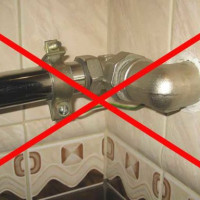 Why a gas pipe is shocking: causes and ways to cope with a problem
Why a gas pipe is shocking: causes and ways to cope with a problem  The gas burner burns badly: popular faults and recommendations for their elimination
The gas burner burns badly: popular faults and recommendations for their elimination  Why the gas burner is noisy: analysis of the causes + valuable recommendations for resolving the problem
Why the gas burner is noisy: analysis of the causes + valuable recommendations for resolving the problem 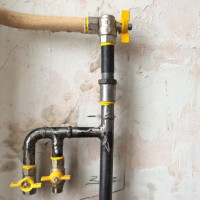 Why does the gas pipe in the apartment vibrate and buzz: causes of noise and solutions to the problem
Why does the gas pipe in the apartment vibrate and buzz: causes of noise and solutions to the problem  What to do if a gas stove passes gas: causes of gas leakage and their elimination
What to do if a gas stove passes gas: causes of gas leakage and their elimination 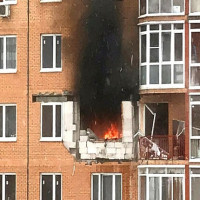 Why gas cylinders explode: root causes and preventive measures
Why gas cylinders explode: root causes and preventive measures  How much does it cost to connect gas to a private house: the price of organizing gas supply
How much does it cost to connect gas to a private house: the price of organizing gas supply  The best washing machines with dryer: model rating and customer tips
The best washing machines with dryer: model rating and customer tips  What is the color temperature of light and the nuances of choosing the temperature of the lamps to suit your needs
What is the color temperature of light and the nuances of choosing the temperature of the lamps to suit your needs  Replacement of a geyser in an apartment: replacement paperwork + basic norms and requirements
Replacement of a geyser in an apartment: replacement paperwork + basic norms and requirements